|
Preview the upcoming FermiNews story
Click on images to view slightly larger pictures
Shift-click on links to download specific versions
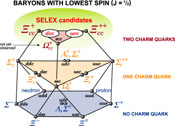
|
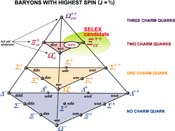
|
|
High res image
|
High res image
|
Classification of baryons:
The four lightest quarks - up, down, strange and charm - can be arranged in 20 different ways to create baryons, composite particles containing three quarks. Some of the combinations come in two different spin states: an excited state (J=3/2) and a ground state (J=1/2). The SELEX experiment has found candidates for three previously unobserved baryons, all containing two charm quarks.
|
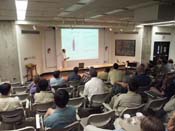
|
|
High res image
|
About 90 scientists attended the SELEX announcement on May 31.
|
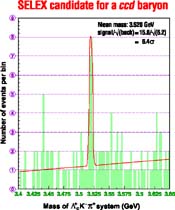
|
The SELEX collaboration has observed three new massive particles. This plot
unveils 16 examples of a particle with mass of 3.520 GeV decaying into three
particles: K- pi+ Lambda_c+. The particle is a candidate for the Xi_cc+, a
c-c-d quark combination which has never been observed before.
|
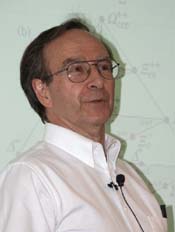
|
|
High res image
|
Cospokesperson Jim Russ presented the new results of the SELEX collaboration
at a seminar at Fermilab.
|
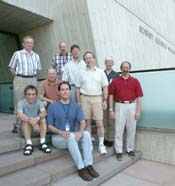
|
|
High res image
|
Some of the members of the SELEX collaboration in front of Fermilab's Wilson Hall. Standing from left: Nikolai Terentyev, Nikolai Kuropatkin (both St. Petersburg, Russia), Jürgen Engelfried (San Luis Potosi, Mexico), Jim Russ (Pittsburgh, Pennsylvania), Loretta Dauwe (Flint, Michigan) and Peter Cooper (Batavia, Illinois). Front row from left: Nikolai Bondar (St. Petersburg), Joe Lach (Batavia), Mark Mattson (Detroit, Michigan) |
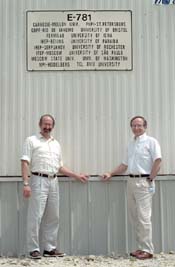
|
|
High res image
|
Peter Cooper (left) and Jim Russ, spokespersons of the SELEX experiment (E-781). The sign displays the names of collaborating institutions from around the world. |

|
|
High res image
|
Peter Cooper (left) from Fermilab and Jim Russ of Carnegie Mellon University |
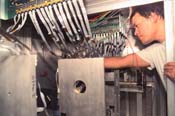
|
| High res image
|
Mark Mattson checks the silicon vertex detectors of the SELEX experiment. The detectors, which allow for precision measurements of particle tracks, are essential to identify short-lived charm particles. Mattson, a former graduate student at Carnegie Mellon University, wrote his thesis about the search for doubly-charmed baryons.
|
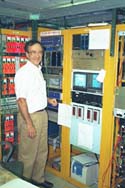
|
Jim Russ, cospokesperson of the SELEX collaboration, in the control room of the experiment
|
|